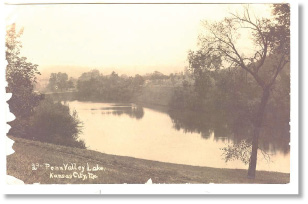
By MICHAEL BUSHNELL
Northeast News
September 19, 2012
This 3-acre lake shown on this real photo postcard published by the North American Postcard Company of Kansas City was once part of “Vinegar Hill,” considered by many to be a slum area of the city. It was described in a published account in 1921 as: “ugly old Vinegar Hill, shanty-clad, dirty and with many of those derelict elements that often crowd about railroad stations.”
Those shacks and shanties were all razed in 1900 when the city acquired the land, and work on the 176-acre park began. Noted landscape architect George E. Kessler oversaw the construction of the park, and was ultimately responsible for the design of much of Kansas City’s growing parks and boulevards system. Kessler’s work with Kansas City’s park board started in 1892 when he was hired to transform the West Bluffs, Hyde Park and Vinegar Hill areas into some of Kansas City’s most beautiful parks and models for the burgeoning City Beautiful movement. Kessler’s plans continued through the years as part of the “Kansas City Plan.”
Kessler initially encountered much public opposition to his ambitious plans, but he was firmly backed by Park Board President A. R. Meyer and William Rockhill Nelson, publisher and owner of The Kansas City Star.
Penn Valley Park lies in what is now considered “midtown” Kansas City between 31st and Pershing Road, running from Wyandotte to Summit. In 1906, Kansas City was awarded second place among major U.S. cities for its “comprehensive, connected and completed park and boulevard system.” Much credit for that honor went to George Kessler.
The North American Postcard Company was owned by W.H. Martin of Ottawa, Kan. Martin was a prolific producer of real photo postcards of the American West as well as a full line of exaggeration postcards. Martin’s exaggeration postcards depicted huge fruits, vegetables and animals superimposed over seemingly “normal” sized human beings.


















